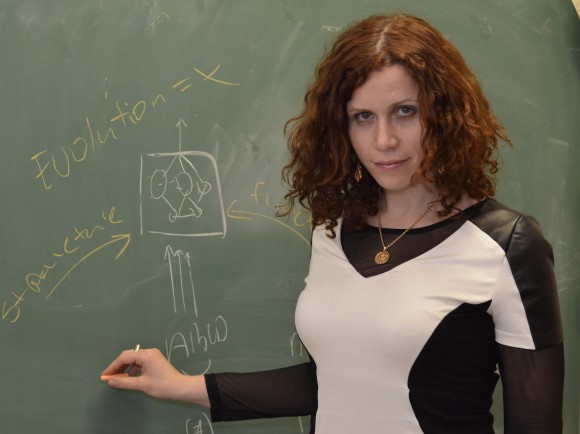
Yana Bromberg
How can you tell one microbial species from another? One way is to compare species functional abilities encoded in microbial DNA. To do so experimentally, that is to design and carry out bench experiments to establish the molecular functions of every gene in every microbial genome, is not feasible. Bioinformatics, an interdisciplinary field that combines computer science and biology, enables this kind of biologically relevant analyses in silico, i.e. using computational models.
Beginning this summer, Yana Bromberg, assistant professor in the Department of Microbiology and Biochemistry, will start research to address this question at the Institute for Advanced Study at the Technical University of Munich (TUM-IAS) in Germany, under a TUM-IAS Hans Fischer Fellowship for outstanding early-career scientists. This three-year fellowship supports a Ph.D.-level graduate student to work under Bromberg’s supervision. It also provides financial support that will allow Bromberg to spend time at TUM-IAS refining and developing advanced bioinformatics techniques useful in medical research and industrial applications.
Bromberg will collaborate with Burkhard Rost, head of the Unit for Computational Biology & Bioinformatics at the Department of Informatics of the Technical University of Munch (TUM). In the scope of this project, Rost and Bromberg will develop new computational algorithms for the exploration of the microbial world. Their work will help us to better understand certain biological functions that can only be carried out by coordinated community-wide microbial actions.
Bromberg couldn’t be happier with the news of this fellowship. “I am very, very excited by this fellowship because it allows me to look at microbial classes in a manner very different than one prescribed by the current scientific standards. This project is pretty ambitious and informative outcomes are not guaranteed, so I was not at all sure about applying. However, I believe that we can learn a lot about everything from biofuels to medicine by taking cue from organisms adapting to their different environments.” She added, “I am happy that I managed to convince the reviewers to give this project a chance.”
This fellowship funds “high risk, high reward” research and is named for TUM Professor Hans Fischer (1881-1945), a pioneering biochemist who received the Nobel Prize in Chemistry in 1930. Fellows are given the freedom to pursue research activities that have longer-term applications. The award is for 80,000 Euro, which will cover Bromberg’s living and research expenses while at TUM-IAS, plus additional funding for graduate student support over three years. Through this fellowship, Bromberg is encouraged to spend a significant time at TUM to participate in the institute’s events and to develop a lasting international network.
Bromberg hopes that her function-based approach to quantifying microorganism similarity, in conjunction with a new metagenomic functions mapping algorithm, will significantly contribute to the understanding of the microbial world. It will enable scientists to reexamine the existing sequence data in a new way and will facilitate further microbial research. In this way, the proposed work will contribute to the innovation of the scientific or technological environment at Rutgers, TUM and beyond.

